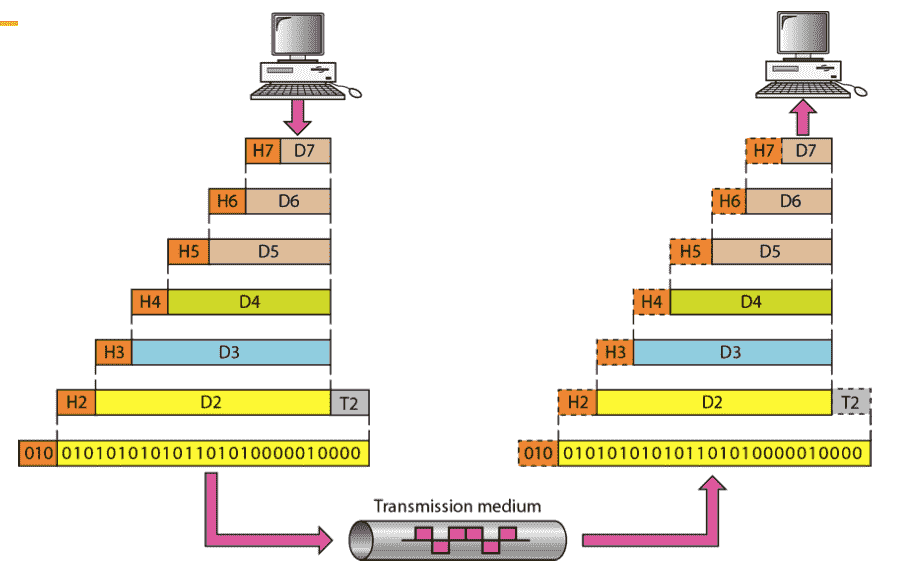02 Layers
Task of moving information b/w computers over the network is divided into smaller and more manageable problems.
Each problem is considered as a different layer in the network, which reduces complexity.
Each layer
- provides service to layer above & belo
- communicates with the same layer’s software or hardware on other computer
There are 2 network standards
ISO OSI Standard¶
Open System Interconnection
The upper 3 layers of the OSI model (application, presentation and session—Layers 7, 6 and 5) are orientated more toward services to the applications
Lower 4 layers (transport, network, data link and physical —Layers 4, 3, 2, and 1) are concerned with the flow of data from end to end through the network.

| Type | Layer | Description | PDU | Device/Example | Address | Delivery | Protocols | Transmission Mode | Line Configuration | Service Type |
|---|---|---|---|---|---|---|---|---|---|---|
| Logical | Application | Provides network-access services to user | Data/Page | Whatsapp Browser Mail client | HTTP FTP SMTP SNMP DNS NFS Telnet DHCP | |||||
| Presentation | Data/File format Data Translation Protocol conversion Syntax & Semantics Compression/Decompression Encryption/Decryption | Data/Page | SSL TLS | |||||||
| Session | Session creation, maintainence, termination Dialogue control & synchronization b/w 2 end systems Token Management Password Validation Logical connection request Synchronization & checkpointing of pages | Data/Page | PPTP SIP SAP Net BIOS | Half-duplex Full-duplex | ||||||
| Transport | Ensuring reliable data exchange mechanism Error control (only end-systems: source-dest) Flow control Connection control Service point addressing Segmentation/Re-assembly into/from a packet | Segment | Port (identifies process/service) | Process-to-Process | TCP UDP | Multiplex | Connectionless Connection-oriented | |||
| Hardware | Network | Inter-Networking Routing algo IP addressing Congestion handling Packetizing Fragmenting | Packet/ Datagram | Router | IP | Host-to-Host | IPv4, IPv6 IPSec ICMP IGP EGP OGHP RARP ARP | |||
| Data Link | Ensuring reliable communication over physical layer ‘Framing’/Reassembling Error control (router & end-system: source-dest + each hop) Error correction/handling Corruption detection/correction Flow control (pacing b/w adjacent sending & receiving nodes) Access control LAN formation Physical addressing & matching | Frame | Bridges Switches | MAC | Hop-to-Hop Delivery | ATM SLIP Frame Relay PPP | Simplex Half-Duplex Full-Duplex | Point-to-Point Broadcast | ||
| Physical | Convert signal b/w digital & analog Encryption & decryption Representation of bits Data rate Synchronization of bits Encoding Modulation Line Configuration Transmission medium Transmission mode Topology | Bitstream/ Raw Data | Hub Repeater | USB Bluetooth | Connection-Oriented (most reliable layer) |
PDU¶
Protocol data unit
PDU’s are used for peer-to-peer contact between corresponding layers
Packet¶
| H3 (Header) | Data |
|---|---|
| Source IP address Destination IP address |
Frame¶
| H2 (Header of layer 2) | Data | T2 (Trailer of layer 2) |
|---|---|---|
| Source MAC Address Destination MAC Address (found through Hop-to-Hop Delivery) | Usually a parity |
Analogy¶
12 kids in Ann’s house sending letters to 12 kids in Bill’s house:
- hosts = houses
- processes = kids
- app messages = letters in envelopes
transport protocol = Ann’ multiplexing and Bill’ demultiplexing to in-house siblings
network-layer protocol = postal service
TCP/IP¶
Transmission Control Protocol with inter-networking protocol
- Application
- Transport
- Network
- Data Link
- Physical
OSI vs TCP/IP¶
| OSI | TCP/IP | |
|---|---|---|
| No of Layers | 7 | 5 |
| Transport Layer | Connection-oriented/Connection-less | Connection-oriented/Connection-less |
| Network layer | Connection-oriented | Connection-less |
| Delivery model | ‘Best’ | ‘Best-effort’ |
Addresses¶
| Address | Size (in Bits) | Denotion | Example | Separator | Connect device in ___ network | Set during | Fixed | Administered by | Portable |
|---|---|---|---|---|---|---|---|---|---|
| Specific | |||||||||
| Port | 16 | Decimal | 753 (0-1024 are reserved) | (none; it is a single no) | |||||
| IP/Logical/Host | 32 | Decimal | 192.168.22.5 | Dot | different | Connection to network | ❌ | ❌ (address depends on connected IP subnet) | |
| MAC(Medium Access Control)/ Ethernet/ LAN/ Physical/ Link | 48 24 Vendor Code, 24 Serial No) | Hexadecimal | AA.F0.C1.E2.77.51 | Colon (Linux) Hyphen (Windows) | same | Device manufacture | ✅ (usually burnt into NIC ROM; sometimes software-configurable) | IEEE (Manufacturer buys portion of MAC address space for uniqueness) | ✅ (LAN card can be moved) |
- MAC address is like Social Security Number
- IP address is like postal address
idk¶
The physical addresses will change from hop to hop, but the logical and port addresses usually remain the same. Huh???
IPv4¶
| Class | Byte 1 (Decimal) | Byte 1 (Binary) |
|---|---|---|
| A | 0-127 | 0… |
| B | 128-191 | 10… |
| C | 192-223 | 110… |
| D | 224-299 | 1110… |
| E | 240-255 | 1111… |
Network ID is the first IP address, for eg: 10.0.0.0, 20.0.0.0. This is used to refer to all devices in a network.
Only end-devices and routers require IP address, as they belong to network layer.
Protocols¶
| Layer | Protocol | Full Form | Details |
|---|---|---|---|
| Network | IP | Internet Protocol | |
| Network | ICMP | Internet Control Message Protocol | ping command uses this |
| Network | IGMP | Internet Group Message Protocol | |
| Network + Data Link (Hybrid) | ARP | Address resolution protocol | Convert ip address to mac address |
| Network + Data Link (Hybrid) | RARP | Reversed Address resolution protocol | Convert mac address to ip address (Only required when connecting to a network for the first time) |